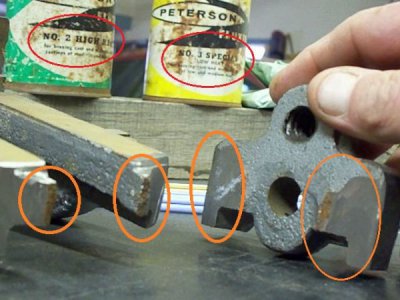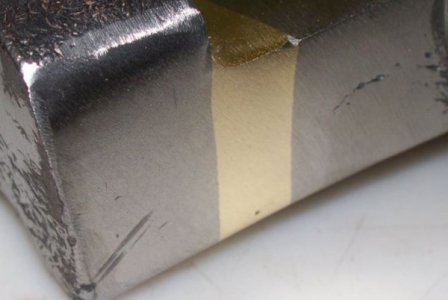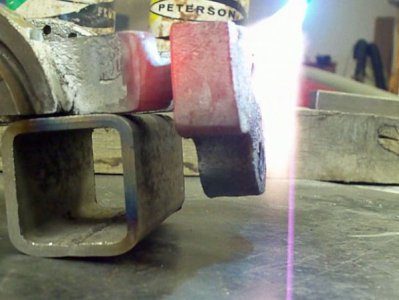-
Welcome back Guest! Did you know you can mentor other members here at H-M? If not, please check out our Relaunch of Hobby Machinist Mentoring Program!
You are using an out of date browser. It may not display this or other websites correctly.
You should upgrade or use an alternative browser.
You should upgrade or use an alternative browser.
Welding Repair,... Cast Iron?
- Thread starter Robo_Pi
- Start date
Ive found brazing with a cast iron scaling powder cures a lot of ills with proper wetting.............but for a heavy item like the vise,preheating to near red heat is essential..........otherwise the filler will never "wet" the cast iron,as the brass melting temperature isnt reached in the iron,only on the surface..............as to nickle arc welding rods..........maybe Bill Gates can afford them.....I cant.
Another point,even the messiest braze is easily fixed by pre heating to red heat,coating with flux,and remelting the brass filler,when it will flash over the iron in a perfect braze as soon as brass melting temp is reached.......in fact ,with preheat ,its often a challenge to stop brass from flashing everywhere,because its hard to remove from unwanted areas.
- Joined
- Feb 18, 2016
- Messages
- 451
.............but for a heavy item like the vise,preheating to near red heat is essential.........
That was most likely the problem. At the beginning of the crack the crack was wide and you could see right through it easily. The cast iron did start to glow red at the end. But when I got to the middle of the crack the crack was much tighter and didn't go through the cast iron all the way. And I couldn't get the cast iron to glow red. Even the four burner cutting torch couldn't heat it up enough. Plus I the closer I got to the meat of the vice jaw it became harder and harder to heat. No doubt the mass of the vice jaw was acting like a heat sink sucking all the heat away.
A bigger torch would have definitely helped. Let's blame it on the torch.

I feel good that the worst part of the crack took a good deep brazing. The brass really got sucked into that part of the crack really well. This will probably be strong enough for my intended use for this vice.
In the meantime I need to by a bigger torch. Or find my larger tip. I know I have one. It's not in the toolbox where it belongs and it's anyone's guess where it might be living now. I can't even remember the last time I used the large torch tip. I'm typically brazing sheet metal with the small tip. The large tip is here somewhere. Someday it will show up.
- Joined
- Mar 29, 2017
- Messages
- 737
Cast Iron is just not straightforward. SO many variables with content, impurities, surface condition, age, blah,blah blah. I think ya done good, and the comments by John.K are just what my Uncle said. If you are gonna braze cast iron, find the grizzled veteran and ask HIM what flux HE uses!
Hi Guys, I dont want everyone to think Im a no-it-all, but have done alot of brazing, about 16 years worth, almost every day,, so I'll post a few pics and also say that the flux is most important, I used a general 1/8" or 3/16" bronze rod, with a #1, 2, 3 peterson flux, The #1 is blue can not shown, they sell small cans...
Dont use coated rods, you want to use a little of each flux as your brazing, and your surface needs to be tinned or else it will just be a glob mess and will never hold any strength, a good brazing job will be stronger than the cast iron, the part should be heated to a dull red, then only will the brazing begin..I've done hundreds of brazing jobs and never had a return for any reason,,,
anyway, if you need any help just let me know, Brazing will be an lost art soon and it would be nice to teach others to keep it going, and there
is some money to be made for a good man that can braze.
Notice that I ground the brazed weld, but is not necessary, its just for looks.



Dont use coated rods, you want to use a little of each flux as your brazing, and your surface needs to be tinned or else it will just be a glob mess and will never hold any strength, a good brazing job will be stronger than the cast iron, the part should be heated to a dull red, then only will the brazing begin..I've done hundreds of brazing jobs and never had a return for any reason,,,
anyway, if you need any help just let me know, Brazing will be an lost art soon and it would be nice to teach others to keep it going, and there
is some money to be made for a good man that can braze.
Notice that I ground the brazed weld, but is not necessary, its just for looks.



Attachments
- Joined
- Feb 1, 2015
- Messages
- 9,608
Not an expert on cast iron repair but here are a few points. Brazing, like soldering, is best done by letting the work melt the filler. This ensures that the work is hot enough to flow the filler into the joint.
Also, when cast iron cools quickly after welding, it forms white cast iron adjacent to the weld which is extremely brittle. IMO, a primary reason for preheating is to ensure that the weld area cools slowly, converting the white cast to grey cast which is malleable.
A similar effect occurs when welding high carbon steel. For that reason, I will preheat and/or post heat any welds to ensure the slow cooling and subsequent annealing of the weld area.
Also, when cast iron cools quickly after welding, it forms white cast iron adjacent to the weld which is extremely brittle. IMO, a primary reason for preheating is to ensure that the weld area cools slowly, converting the white cast to grey cast which is malleable.
A similar effect occurs when welding high carbon steel. For that reason, I will preheat and/or post heat any welds to ensure the slow cooling and subsequent annealing of the weld area.
Good points RJSakowski
I always post heated the weld after, and made sure it cooled slowly.
Back in the day when we used asbestos sheets, a few bricks and a sheet of asbestos made a good tent.
Yes, there is more than just heating and slopping bronze on.
I always post heated the weld after, and made sure it cooled slowly.
Back in the day when we used asbestos sheets, a few bricks and a sheet of asbestos made a good tent.
Yes, there is more than just heating and slopping bronze on.
- Joined
- Jun 7, 2013
- Messages
- 10,089
I have had very good luck brazing cast iron, I use bare bronze rod, prep by grinding and feather back the edges of the prep, and goop it up with silver solder flux to protect the prepared area from oxidation while preheating and brazing, and us Anti Borax EZ#3 flux during the brazing process, the bronze will wet out like solder without beading up anywhere, if I have a "secret" the silver solder flux is it, and the Anti Borax flux is the best that I have ever used, it is colored black.
Anti Borax EZ#3 flux during the brazing process, the bronze will wet out like solder without beading up anywhere, if I have a "secret" the silver solder flux is it, and the Anti Borax flux is the best that I have ever used, it is colored black.
Have never heard of those fluxes, I'm so use to using Peterson brand fluxes, and the price is right, I also use it to de-gas and remove dross just before an aluminum pour.
I'm sure yours works better, as Peterson fluxes haven't changed for 100 years..by getting a good tinning and flow it should be a sound weld.


